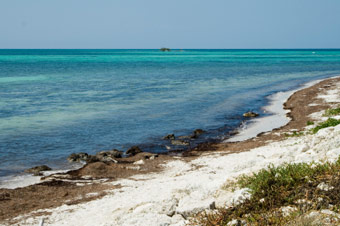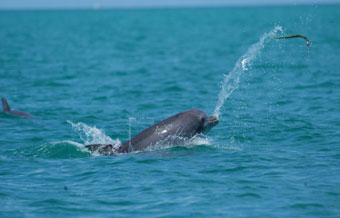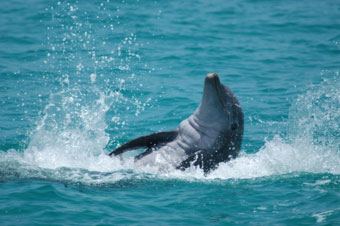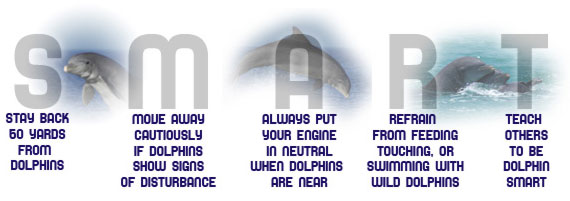Dolphin SMART: A Win-Win Conservation and Business Model
Viewing marine mammals in the wild is big business with an estimated economic impact of nearly $1 billion USD in 2008. According to an International Fund for Animal Welfare (IFAW) 2009 report, the United States has the world’s largest marine mammal viewing industry with approximately five million participants – 250,000 of which specifically view dolphins. From New York to Georgia at least 50 businesses engage in such activities while Gulf of Mexico states host approximately 125 dolphin-viewing businesses, with Florida in the forefront. When considering the significance of this growing industry, it’s imperative to consider its effects not only on the animals’ health, but also on the Southeastern United States’ culture and economic viability.
Throughout Southeastern United States, numerous bays are home to bottlenose dolphins. Most reside in these locations year-round because the habitat is ideal to raise young, to feed and to socialize, as well as for overall survival. To prevent disturbance of such crucial dolphin behavior, it’s necessary for these bays to remain safe-havens and productive habitats. Furthermore, activities that cause potential behavior disturbances are illegal under the Marine Mammal Protection Act (MMPA) because of possible short– and long-term harm to animals.
Protection of dolphins and their habitat is an important factor in economic sustainability of dolphin-viewing businesses. Even unintended disturbance from people and boats can significantly alter dolphin behavior and harm the animals. In extreme cases, these marine mammals will permanently move away from their residential bay habitat, thus crippling the area’s viewing industry. Harassment can include separating or surrounding dolphin groups, erratically and quickly approaching dolphins, or any other activity that may change the animal’s behaviors. Feeding or attempting to feed wild dolphins is also expressly illegal under the MMPA.
Harassment and feeding wild dolphins also puts them at greater risk for boat strikes and fishing gear entanglement. For example, a marked increase in dolphin injuries associated with human interaction has been occurring in Southeastern U.S. Seventeen stranded dolphins were found with evidence of boat strikes along Florida’s east coast from January 2002 through April 2009. In Florida’s Indian River Lagoon, 63 percent of dolphin strandings within this time frame were associated with hook and line fishing gear. Addressing such conservation concerns is critical since unhealthy or disappearing dolphin populations also mean disappearing business for dolphin-viewing companies.
Business Benefits of Wild Dolphin Conservation
To help protect local wild dolphins from unintentional consequences of close human interactions associated with viewing dolphins, NOAA Fisheries Service and its partners launched a unique, voluntary recognition and education program called Dolphin SMART. The program is for commercial viewing businesses and promotes responsible business practices.

© iStockphoto.com/marcellus2070
Key West, Florida was the catalyst for the program as well as the launching pad. Prior to 2007 approximately 40 businesses conducted dolphin-viewing tours targeting a small geographic area within the Florida Keys National Marine Sanctuary (FKNMS) – home to a small, resident dolphin group. Company advertisements promoted close interactions with the wild animals, thus raising public expectation and providing a false sense that such interactions are not harmful to marine mammals or people. Additionally, high tourist industry turnover created lack of knowledge and awareness of MMPA and NOAA Fisheries’ guidelines and policies to help prevent wild animal harassment. Such factors heightened concerns about increased stress to local dolphin populations in conjunction with increased viewing business competition.
With guidance from concerned local dolphin tour businesses and Key West residents, NOAA’s Fisheries and National Marine Sanctuary Program, in partnership with the Dolphin Ecology Project and Whale and Dolphin Conservation Society, developed Dolphin SMART. The result was a one-of-a kind program combining viewing and advertising criteria, training, field research, evaluations, outreach and education. Experts train participating businesses on how to follow program criteria, laws and regulations, as well as on how to recognize natural wild dolphin behavior (versus behavior resulting from disturbance). Responsible viewing criteria includes, but is not limited to: staying 50 yards away from dolphins upon initial approach, using extra caution around mothers and calves, and slowly moving away if animals show signs of disturbance. Dolphin SMART businesses only advertise natural wild dolphin behavior to help prevent expectation of close interaction with animals in the wild.
As the world embraces a “green” vision, many companies are striving to meet customers’ expectations of responsible and environmentally friendly business practices. Dolphin SMART is unique because it includes crucial elements for protecting wild dolphins while providing incentives for commercial businesses that voluntarily participate.
Advantages of Responsible Business
Dolphin SMART embraces the “green” shift in American culture and helps viewing businesses achieve responsible business practices through cause marketing. Cause marketing integrates social and environmental issues into brand awareness to generate business and social benefits. More simply, it’s a strategy to boost sales by showing support for important causes. An example of one recognizable and successful campaign is Susan G. Komen for the Cure. Participating companies support the cause by producing pink products with a portion of the proceeds going to breast cancer research.

© Dolphin Ecology Project
Cause marketing success is based on American attitudes and actions, which were documented through studies and surveys conducted by Cone Inc. and Duke University.1 Specifically, 85 percent of Americans have a more positive image of a company when it supports a cause they care about. Therefore, Dolphin SMART is an important choice for people who want to show their support for wild dolphin conservation as they enjoy viewing these animals in their natural habitat and in a sustainable manner. Cone also found that 91 percent of Americans want companies to tell them how they’re supporting the cause.
Dolphin SMART accomplishes this by requiring participating businesses to provide an educational briefing before the tour explaining the importance of responsible viewing and how the program helps wild dolphins. Dolphin SMART also provides participating businesses with program logos and statements for use on advertisements, websites, boat flags and decals. As competition for dolphin viewing increases, Dolphin SMART provides participating businesses a competitive edge by showing their support for an environmental cause and by conducting sustainable business practices.
For cause marketing to be effective, it must provide tools, products, events and materials to help increase recognition for the program and participating businesses, as well as educate the public about the mission. To this end, additional incentives for businesses to participate in Dolphin SMART include:
- educational training workshops and materials;
- fun and informative educational materials about wild dolphin biology and conservation;
- recognition through program partner participation in local outreach events promoting the program, which includes program media.
Dolphin SMART is mutually beneficial to wild dolphin conservation efforts and participating businesses. Companies gain a competitive edge by offering customers an enhanced tour experience while demonstrating their commitment to responsible wildlife viewing, dolphin conservation and economic sustainability. In the process, Dolphin SMART participants and their guests become bottlenose dolphin stewards.

© Dolphin Ecology Project
Interest in Dolphin SMART has grown throughout the United States with additional programs now operating in Orange Beach, Alabama and along Florida’s southwest coast. Ten area businesses have been recognized for their successful participation and dedication to sustainable business practices: Islescapes Cruises, Dolphin Safari Charters, Sunny Days Catamarans, Cetacean Cruises, Skipper J Dolphin Cruises, Adventure Cruises, Banana Bay Tour Company, Ft. Desoto Eco Adventures, Tarpon Bay Explorers and the Shell Key Shuttle. And, Dolphin SMART may soon be expanding to Hawaii to help prevent disturbance to spinner dolphins.
After the Dolphin SMART launch, other area businesses wanted to support wild dolphin conservation by promoting the program. Therefore, in 2010 the program featured a new element called “Proud Supporters of Dolphin SMART,” which offers additional businesses an opportunity to raise public awareness for responsible wild dolphin viewing. This increased program awareness helps educate the public about the importance of booking viewing tours with Dolphin SMART. Currently, more than 25 Proud Supporters show their commitment to wild dolphin conservation throughout Florida and Alabama.
How to Help
It’s important to simply, “Look before you book.” When booking a wild dolphin viewing tour, look for the Dolphin SMART logo and current year on boat decals, flags and businesses advertisements. Or, visit www.dolphinsmart.org to find Dolphin SMART businesses. If Dolphin SMART is not yet in the area, remember the cornerstones of the program when choosing a tour: responsible viewing and advertising. Look for businesses that follow NOAA Fisheries Southeast Viewing Guidelines for Marine Mammals and Sea Turtles (http://www.nmfs.noaa.gov/pr/education/southeast/) and that advertise only natural wild dolphin experiences without close interaction.
Anyone can view wild dolphins responsibly while enjoying a day on the water. Follow the NOAA Fisheries Southeast Viewing Guidelines for Marine Mammals and Sea Turtles and remember the Dolphin SMART acronym: S – Stay back 60 yards from dolphins; M – Move always cautiously if dolphins show signs of disturbance; A – Always put your engine in neutral when dolphins are near; R – Refrain from feeding, touching or swimming with wild dolphins; T – Teach others to be dolphin smart. By being Dolphin SMART, anyone can become a dolphin steward while being rewarded with fascinating, natural, wild behavior.





























